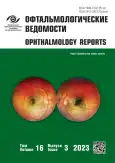Changing the geometry of polymer spherical orbital implants
- Authors: Davydov D.V.1,2, Baranova N.A.2
-
Affiliations:
- P.A. Hertsen Moscow Oncology Research Institute
- Diagnostic Center No. 7 (ophthalmological) for adults and children
- Issue: Vol 16, No 3 (2023)
- Pages: 27-36
- Section: Original study articles
- URL: https://journals.rcsi.science/ov/article/view/148217
- DOI: https://doi.org/10.17816/OV546107
- ID: 148217
Cite item
Abstract
BACKGROUND: Over the past decades, various polymer implants have been actively used in the rehabilitation of patients with anophthalmos to form a volumetric support stump and improve the results of cosmetic prosthetics.
AIM: To assess clinical symptoms and features of the X-ray picture in patients with anophthalmos after implantation of polymeric spherical endoprostheses with a modified geometry.
MATERIALS AND METHODS: The study is based on the analysis of 30 patients with anophthalmos after enucleations (23) and eviscerations (7) performed using various methods of procedure and insertion into tissues of an implant made of domestic polytetrafluoroethylene. All patients underwent a multispiral computed tomography (MSCT) of the eye sockets according to the same algorithm.
RESULTS: On the basis of the performed studies, the fact of making a change in the geometry of the implanted spherical implants was revealed, while the parameters of the modified part of the spheres were different and ranged from 14 to 18 mm of final diameters with the initial diameters of the spheres ranging from 18 to 20 mm. A decrease in the volume of spheres with modified geometry from 0.114 to 0.651 cm3 was revealed with initial diameters ranging from 18 to 20 mm.
CONCLUSIONS: Changes in the geometry of the orbital spheres do not improve the results of cosmetic prosthetics in patients, increase the percentage of implant exposure at different times after surgery, and increase the manifestations of anophthalmic syndrome.
Full Text
##article.viewOnOriginalSite##About the authors
Dmitry V. Davydov
P.A. Hertsen Moscow Oncology Research Institute; Diagnostic Center No. 7 (ophthalmological) for adults and children
Author for correspondence.
Email: d-davydov3@yandex.ru
ORCID iD: 0000-0001-5506-6021
http://www.doctordavydov.com
Professor, Head of the Department of Oncoplastic Surgery
Russian Federation, Moscow; Saint PetersburgNadezda A. Baranova
Diagnostic Center No. 7 (ophthalmological) for adults and children
Email: baranova-n@bk.ru
Ophthalmologist, Head, Laboratory of Ocular Prosthesis
Russian Federation, Saint PetersburgReferences
- Plateh NA, Valuev LI. Polimery v kontakte s zhivym organizmom. Moscow: Znanie, 1987. 48 p. (In Russ.)
- Perova NV. Differentsirovannyi podkhod k doklinicheskoi otsenke biologicheskoi bezopasnosti implantatov [dissertation abstract]. Moscow, 2004. (In Russ.)
- Got’e SV, editor. Transplantologiya: itogi i perspektivy. 2011. Vol. 3. Moscow; Tver: Triada, 2012. 416 p. (In Russ.)
- Perova NV, Sevast’yanov VI. Osobennosti ispytanii meditsinskikh izdelii. Partnery i konkurenty. 2002;(6):37–40. (In Russ.)
- Fyodorov SN, Davydov DV, Vasiliev AV, et al. Application of human skin postnatal fibroblast cultures in ophtalmotoxicologic studies. Ophtalmosurgery. 1998;(3):49–53. (In Russ.)
- Ivolgina IV, Fabrikantov OL. Peculiarities of using different implants to form the functioning stump following enucleation and analysis of the outcomes. Practical medicine. 2018;16(4):129–132. (In Russ.)
- Bakaeva TV. Sovremennye biointegriruemye implantatsionnye materialy, primenyaemye v khirurgii orbity. Ehksperimental’no-klinicheskoe issledovanie [dissertation abstract]. Moscow, 2011. 24 с. (In Russ.)
- Davydov DV, Valuev LI, Sytov GA, et al. Gidrogeli v rekonstruktsii anoftal’micheskoi orbity. Proceedings of the III international conferences: “Sovremennye podkhody k razrabotke perevyazochnykh sredstv, shovnogo materiala i polimernykh implantatov”. Moscow, 1998. P. 310–311. (In Russ.)
- Shevchenko L, Boss J, Shah CT, et al. Alphasphere as a successful ocular implant in primary enucleation and secondary orbital implant exchange. Orbit. 2013;32(3):161–165. doi: 10.3109/01676830.2013.772208
- Karesh JW, Dresner SC. High-density porous polyethylene (Medpor) as a successful anophthalmic socket implant. Ophthalmology. 1994;101(10):1688–1695. doi: 10.1016/S0161-6420(94)31114-6
- Wang J-K, Lai P-C, Liao SL. Late exposure of the bioceramic orbital implant. Am J Ophthalmol. 2009;147(1):162–170.e1. doi: 10.1016/j.ajo.2008.05.001
- Wells TS, Harris GJ. Direct fixation of extraocular muscles to a silicone sphere: a cost-sensitive, low-risk enucleation procedure. Ophthalmic Plast Reconstr Surg. 2011;27(5):364–367. doi: 10.1097/IOP.0b013e31821c1298
- Nikolaenko VP, Astakhov YuS. Modern porous materials for orbital implant manufacturing. Ophthalmology Reports. 2008;1(2): 35–40. (In Russ.)
- Lezhnev DA, Kostenko DI, Privalova EG. The possibilities of modern tomographic technologies in diagnostics and postoperative control of injuries and posttraumatic deformations of the midface. Medical Visualization. 2015;(4):91–100. (In Russ.)
- Pavlova OYu. Luchevaya diagnostika travmaticheskikh povrezhdenii srednei zony chelyustno-litsevoi oblasti na do- i posleoperatsionnykh ehtapakh lecheniya [dissertation abstract]. Moscow, 2019. 24 p. (In Russ.)
- Pavlova OYu, Serova NS. Protokol multispiralnoi kompyuternoi tomografii v diagnostike travm srednei zony litsa. Russian Electronic Journal of Radiology. 2016;6(3):48–53. (In Russ.) doi: 10.21569/2222-7415-2016-6-3-48-53
- Tabet AAA. Korrektsiya ostatochnykh posttravmaticheskikh deformatsii periorbital’nykh tkanei individual’nymi silikonovymi implantatami [dissertation abstract]. Moscow, 2011. (In Russ.)
- Perova NV. Differentsirovannyi podkhod k doklinicheskoi otsenke biologicheskoi bezopasnosti implantatov [dissertation abstract]. Moscow, 2004. 53 p. (In Russ.)
- Rokohl AC, Trester M, Guo Y, et al. Dry anophthalmic socket syndrome — Standardized clinical evaluation of symptoms and signs. Ocul Surf. 2020;18(3):453–459. doi: 10.1016/j.jtos.2020.05.001
- Perova NV, Dovzhik IA, Sevastyanov VI. Biological effect evaluation of medical devices (toxicology studies). Vestnik roszdravnadzora. 2015;(3):26–28. (In Russ.)
Supplementary files


















